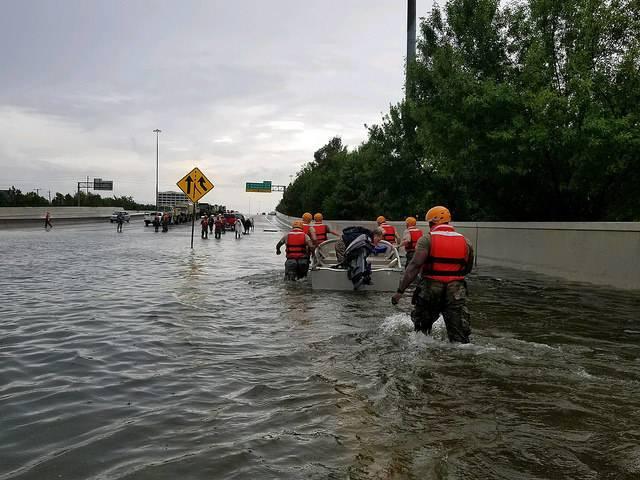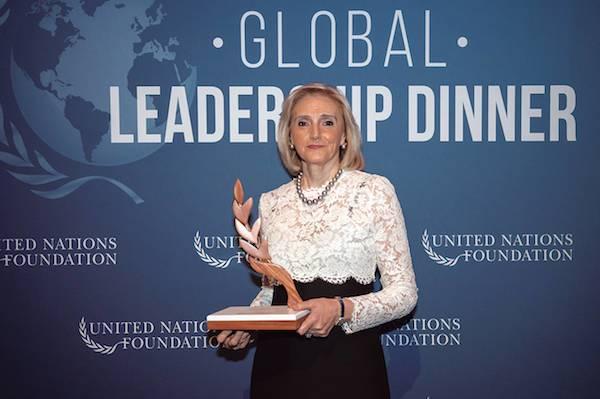Interface Changes the Story on Climate Change from Pessimism to Optimism


In the run-up to the Companies vs Climate Change conference, Olivia Sprinkel, Head of Salterbaxter North America, spoke with Christine Needles, Senior Director, Global Corporate Communications for Interface. Christine is one of the panelists at the conference speaking about communicating on climate change.
Olivia Sprinkel: Let’s start with looking at what Interface is doing on climate change. Interface’s updated sustainability strategy is called Climate Take Back. Why the focus on climate?
Christine Needles: Two years ago, Interface brought together our Eco Dream team members, including Paul Hawken, Janine Benyus, Bill Browning and others from the original group that worked with Ray Anderson to help guide our sustainability mission. We were not too far from our Mission Zero target of eliminating any negative environmental impact by 2020. So it was time to take a look at what to do next. And climate is at the center of so many different issues. It has a huge ripple effect, including societal impacts and welfare impacts. From where we stood, we saw that if we tackled this big issue, we would be able to have a much bigger impact on all of these other issues – and surveying our customers, our employees and other stakeholders reaffirmed our approach.
Climate change is the biggest threat to humanity and to our institutions. In keeping with the spirit and legacy of our company, we see this is an opportunity to have a positive, lasting impact. Climate Take Back is a direct evolution of Mission Zero, and in keeping with Ray Anderson’s vision of a restorative organization.
OS: What are your areas of focus within Climate Take Back?
CN: Our main areas of focus are:
- Live Zero – take only what can be replaced. If other companies had that as their mantra, imagine what that could look like?
- Love Carbon – see carbon as a resource, use it as a building block. We have launched a new concept tile, our Proof Positive tile, which has a negative carbon footprint. The tile is made with raw materials that store carbon, resulting in less carbon dioxide in the atmosphere than if it had not been manufactured in the first place.
- Let Nature Cool – mimic nature’s strategies, help nature do its own job to cool. At Interface we’re exploring the idea of Factories as a Forest. What are some things we can to do to be a contributor rather than a detractor to the local environment? For example, we planted a wall of ivy on the side of a building at our manufacturing site in Australia; this helps to cool the building in summer, and maintain heat in winter.
- Lead the Industrial Re-Revolution – This is about creating new business models that drive change, including the circular economy. Interface is well known for our Net-Works program. We have partnered with the Zoological Society of London and Aquafil to collect discarded fishing nets. This creates opportunities for fishermen to gain additional wages, as well as tackle an environmental problem.
We are now thinking about our own roadmap in these areas. We have also created a plan that is available on Slideshare for other companies to use, and inspire and help them in their own journeys.
OS: Given where we are at, whether recent natural disasters or the political landscape in the US, why we should be talking about climate optimism?
CN: The narrative is doom and gloom. Every single day, there is a new article about how we are heading off the edge of a cliff. The media has a tendency to look for negative stories, in order to get clicks and create debate. Optimism needs to be the name of the game. We’ve got to start getting in front of the media, to change the narrative to enable us to continue to persevere. Solutions exist. And with more demand, comes an improvement in the economy of the solutions. If we focus on what’s not working, that’s not going to solve the problem. Why would industry want to invest if there is no hope? We have to be optimistic. If not us, then who?
There are not a lot of areas where communications are at the front end of the spear. We need to have the real technologies and approaches, but real change first requires a change in mindset. In the case of climate, that starts with optimism and the belief that positive change is possible.
OS: What about communicating with people who don’t believe climate change is an issue?
CN: We need to band together with people who believe. The science exists. I would prefer to spend one minute with a person who wants to make a change, rather than spend that minute trying to convince someone who doesn’t. We need to focus on people we know get it. And we know there are many out there who do. In our recent global survey we found that 95 percent of climate experts and 91 percent of emerging business leaders believe we can create a climate fit for life.
Paul Hawken’s book, ‘Drawdown’ has 100 examples of actions we can take on climate change. We could multiply that list by 10 or 100 fold. We need to build momentum around the actions that we can take with those that have the energy to do so, rather than waste our energy on those who don’t. Events such as Companies vs Climate Change are an opportunity to focus on what we can do, and rally together. We need that as an energy source of optimism.
OS: To finish, what are your top tips for communications on climate change?
CN: First, don’t be afraid to make a big statement. It’s OK not to know all the answers. We’ve got to tackle some big issues. If you don’t name the goal, you are not going to get there. Be bold, don’t be afraid.
Secondly, try as best as you can not to feed into the negative narrative. Support each other. Share. The more optimistic that we are together, the more successful we will be.
And finally, persevere! We all have a lot to juggle. As communicators, we are balancing competing priorities. We are not alone. We have to come together.
Come together and join Christine Needles and a host of professionals involved in taking action on climate change at Companies vs Climate Change in Miami, November 29 to December 1.
To Best Address Climate Change, Sustainability Must Influence Policy


By Andrew Heikkila
In the wake of Hurricane Harvey’s August 2017 landfall in Texas, it’s all but impossible to ignore that climate change is real and represents a devastating future for people around the world. While EPA Administrator Scott Pruitt stated that now is not the time to talk about climate change, TriplePundit contributor Susan Glickman argues that now is exactly the time to talk about climate change.
“What’s insensitive is not talking about the links between warmer surface-water temperatures and more-intense weather events,” she writes. “What’s insensitive is dismantling the Clean Power Plan that was put in place to reduce climate-changing carbon pollution. What’s insensitive is unraveling the environmental protections we all rely on so allies in the oil and gas industry can continue to pollute for free and have consumers pick up the tab.”
Not only that, Glickman reminds, but we’ve know about this problem for over 50 years. In 1965, President Lyndon B. Johnson addressed Congress to deliver a warning concerning climate change:
"Air pollution is no longer confined to isolated places," said Johnson less than three weeks after his 1965 inauguration. "This generation has altered the composition of the atmosphere on a global scale through radioactive materials and a steady increase in carbon dioxide from the burning of fossil fuels."
Green is growing, but is it growing fast enough?
The good news is that not everybody has their heads in the sand. Even though Donald Trump has announced that the U.S. would be withdrawing from the Paris Agreement on Climate Change, the private sector is making their own moves. Trump’s renege announcement came last June, but, as TriplePundit writer Tina Casey puts it, “back then the conventional wisdom was that the world would simply move along without him. Since then there have been many indications that the conventional wisdom was actually right.”
Evidence can be found everywhere that people prefer green initiatives that the Trump administration has disregarded. The solar industry is booming, adding at least 35,000 new in the industry since 2011 and currently employing at least 209,000 panel installers, designers, engineers, sales associates, managers, and others in the U.S. alone. By comparison, the oil and gas industry eliminated more than 17,000 jobs in 2015 alone.
While these initiatives are absolutely necessary, the question is whether or not they’re enough? Heather Clancy, Editorial Director for GreenBiz, thinks that without tapping into policy and restructuring the political landscape, “the march of progress on sustainable business practices — especially toward adopting clean, renewable energy — will slow to a crawl.”
Despite the private sector’s advancements, the people most in need of clean initiatives aren’t finding them accessible.
“While many corporate energy buyers are understandably excited about the various financing options, programs and tax incentives at their disposal to acquire solar and wind power that matches their electricity loads, it's far more difficult to get individual consumers who find it difficult to pay their power bills each month excited about energy efficiency or clean power,” writes Clancy. “The poorest 20 percent of the U.S. population pays 10 percent or more of their entire household income on energy, at least in part because they haven't been able to invest in efficiency measures such as power-sipping appliances.”
This disparity is what has allowed companies like ExxonMobil to paint the sustainability movement as an elitist, whimsical group, disconnected from the hardship and economic realities of those living under or near the poverty line. To level with these populations, private companies and their sustainability teams will have to become more involved in local, state, and federal policy matters to advance progress on clean energy initiatives in a way that includes members from every rung of the social ladder.
Clancy uses Google as an example for how this investment in policy evolution can pay off, mentioning that the company was “at the heart of an effort in North Carolina to craft the renewable energy tariff program that has allowed several large buyers to invest in projects in that state.”
“When Google wanted to begin a $600 million expansion to its Lenoir data center, it pushed Duke Energy to develop something called a ‘Green Source Rider,’” reports NC State University. “It was the first time a program had been requested by a consumer that allows a company to buy electricity that’s produced from renewable sources. It may cost a little more, but Google hopes this strategy will blaze a trail for other electricity customers.”
Google, unfortunately, is the outlier. Very few companies are willing to spend nearly as much as Google has in attempts to influence and reshape policy that makes clean energy more economically accessible to all. ExxonMobil, however, is no stranger to influencing policy — they spent $11.8 million on lobbying expenditures in 2016 alone.
The reality is that this money speaks, and it’s been speaking loudly for the last 50 years at least. Until sustainability groups take the initiative to influence and shape policy, companies like ExxonMobil will continue to do it themselves, come hell, hurricanes, or high water.
Google Provides $10M Grant to Boost Skills Building at Goodwill


Goodwill has been consistently ranked as one of the organizations doing the most to boost skills training for the workers, especially for those who have the least access to such opportunities, including veterans, people with disabilities, the formerly incarcerated and senior citizens.
Now thanks to Google employee volunteers and a $10 million grant from the company, Goodwill recently announced it will have the capacity to offer job training to over one million people over the next three years.
This initiative is an attempt to bridge the mismatch between those who are unemployed and companies who say they struggle finding qualified workers to fill their open positions. As widely reported over the summer, the U.S. Department of Labor has reported that approximately 6 million jobs across the U.S. were unfilled - a problem that has long frustrated employers and job seekers alike.
The problem is that technology is increasingly an important part many jobs, including those positions in manufacturing, retail, customer service or in warehouses.
Google's partnership with Goodwill launched last month in western Pennsylvania, where volunteers employed at Google staffed workshops and training sessions that ranged from applied digital skills to the use of the company's cloud-based applications.
The program, dubbed the Goodwill Career Accelerator, is expanding nationwide, including in Northern California's Bay Area, where Goodwill's employees have started applying their skills by photographing, editing and cataloging items that the non-profit sells on its online portal. As reported by the San Francisco Chronicle, these workers may covet a warehouse job at the likes of Walmart of Amazon, but the days of simply being physically fit enough to lift boxes heavier than 50 pounds or knowing how to pilot a forklift are over - some technical know-how is required by just about any employer. But for job seekers who had been homeless for years, or were imprisoned, they missed out on the ongoing technical revolution - and therein lies one of many obstacles these workers face in their search for a regular paycheck.
Google is one of many technology companies that have realized efforts to accelerate skills building in the U.S. and abroad is in their best interests, whether it is to secure their brand reputation or groom a future pool of employees. Earlier this decade, for example, Microsoft launched a program, YouthSpark, that has aimed to develop technical skills for students, including children who are still in primary school. The enterprise software giant SAP has long viewed technical training programs as a way to boost its inclusion efforts here in the U.S. and as far away as South Africa. And Cisco has worked with NGOs worldwide to boost technical job opportunities, including for women in the Middle East.
“Goodwill is the leading workforce development nonprofit in the United States and Google is proud to support them as they prepare more than one million people across the country to get the critical digital skills they need to be successful today and in the future,” said Jacquelline Fuller, President of Google.org in a public statement. “We both share a commitment to create opportunities for everyone, and we’re excited to amplify Goodwill’s amazing work through our giving and Google volunteers.”
Image credit: Goodwill/Facebook
Vast Improvements for Farmers In Global Cacao Sector, but Much Work Ahead


The global chocolate industry faces a bevy of challenges, including human rights, the environment, sustainable economic development and climate change. One international organization, the World Cocoa Foundation (WCF) says it is on a mission to strengthen the cocoa industry by boosting sustainable development programs in countries where this crop is grown - especially in Côte d’Ivoire and Ghana, which combined is home to 60 percent of cocoa production. Among its several programs, WCF's CocoaAction initiative aims to align some of the world's largest chocolate companies, governments and NGOs.
This week, WCF issued an annual report outlining what the Washington, D.C.-based organization says is the progress it has made on improving sustainability across the global chocolate supply chain.
The organization's largest achievement may help improve transparency and traceability across the entire chocolate industry. Companies working with WCF on its CocoaAction initiative have reached almost 147,000 cocoa farmers across 330 communities in Côte d’Ivoire and Ghana, claims this report's authors. So what exactly does that mean?
Once the reader cuts through the report's jargon, it becomes clear what the chocolate industry needs to work on in order to address the challenges confronting this sector. Those problems include the cocoa swollen shoot virus (CSSV), a constant threat to cocoa farmers, as well as the pests and weeds that are often the bane of cocoa farming.
But there are also many opportunities for companies to work with their supply chains. Partnering with farmers on land management, for example, can help boost yields while improving families' income. Women's empowerment also needs more attention from chocolate companies. A recent Oxfam report shows that while women in Côte d’Ivoire own 25 percent of the country's cocoa plantations and comprise over two-thirds of the industry's workforce, they only earn 21 percent of all the income generated. WCF insists this problem is also on its radar.
Such improvements will be possible, claims WCF, because of all the data it collected from its member companies, including Cargill, Ferrero Group, Hershey, Mars, Mondelēz, Nestlé and Olam. WCF boasts that it now has 15,000 data points from its supply chain in Côte d’Ivoire and Ghana, and that information will allow the industry to adjust its strategy and those of its membership in order to generate more social impact within these countries.
The report, however, does not mention the potential risks climate change has on to the chocolate industry at all. It's quite the oversight, considering the the vast amount of research that has suggested the cocoa industry could face more difficulties in the coming years due to a more volatile climate. In fact, environmental concerns barely merit attention throughout the report. Meanwhile, just about every international organization, including the World Bank, has insisted that climate change risks will make it more difficult to tackle poverty across the world. And when it comes to this industry, Rainforest Alliance only a few weeks ago reminded chocolate lovers that a warming climate threatens to disrupt the lives of millions of smallholder cocoa farmers worldwide.
Unless WCF shows it has more of a plan to help farmers cope with climate change - after all, one of its member companies, Mars, recently promised to invest $1 billion in sustainable supply chain strategies in order to help its suppliers adapt to these risks - the organization's work on "groundbreaking collaboration," "aligning on priority issues," and work on "common interventions" will be for naught.
Image credit: World Agroforestry Centre/Flickr
Hilton Sparks the Arts with Youth Service America


The challenge for many companies who say they want to "do good" is to harness both the talent and passion of employees in a way that maximizes their skills for the benefit of local communities.
One of Hilton's newest brands believes it has found such a path by working with local organizations to unleash the latent "spark" in youth who happen to live in local communities' underserved neighborhoods. Billed as "Spark the Arts," this program aims to unleash the artistic talents of children and teenagers into projects that can have a positive impact on their neighborhoods.
To that end, Tapestry Collection by Hilton, a line of hotels both moderately-priced and designed to offer a unique experience for guests, is now partnering with Washington, D.C.-based Youth Service America (YSA). One of the first programs launched under this initiative is in Syracuse, New York, where a hotel that recently joined this brand works with local community organizations to benefit at-risk kids by bolstering their after school programs.
TriplePundit recently joined Hilton employees who work out of the company's headquarters in suburban D.C. With us were staff from the Hotel Skyler, a LEED Platinum-certified hotel that runs almost entirely on geothermal tower and is largely designed with fixtures made and sourced locally across western New York.
On a brisk fall afternoon, this group hopped into a bus and ventured a few miles to the Westcott Community Center, located in what was once a local firehouse. Nestled in the middle of century-old clapboard houses under fall trees that are starting to boast their autumn colors, the center provides a safe space for kids and mentors to work on a variety of education programs, most of which center on the arts.
For these kids who come to this center after school, the interests, desires and dreams exist - many of them are simply too preoccupied to harness those talents into energy that can help drive their future career and life paths. So last week, Hilton, Hotel Skyler and YSA employees, along with some representatives of the media, spent an afternoon chatting and working with kids, who ranged in age from primary to high school.
Last Wednesday's project was to create "dream boards," a way for kids to channel their interests by affixing pictures and words to a poster board. For about an hour before the approximately 20 students arrived, this group of volunteers set up tables and furiously cut out photos and words from magazines and newspapers. The goal was to get kids to talk about their interests, whether they may have centered in the arts, sports or science. And therein lies the strength of having a group of people from the hospitality industry - after all, at the risk of generalizing, this is a demographic of people who tend to be friendly, outgoing and adventurous.
Just as any project with teenagers, there was plenty of ice that needed to be broken; many of these kids were quiet at first. And who could blame them, as they were sitting with a group of adults they've never seen before in their lives. But as time went on, you could see how these pictures grabbed these kids' attention - as in the case of a middle school student sitting at our table. She was interested in the culinary arts, and rather quickly, the visuals of the pictures helped break down the barriers. That shy student just an hour later an hour was bursting with enthusiasm as the minions from Hilton and the media sitting with her could not snip out pictures fast enough.
At the end of the afternoon, the students were each asked to share their dream boards and talk about their long-term dreams and goals.
In addition to these afternoon programs, the hotel brand and YSA earlier this year launched a grant program for kids and students aged 12 to 25. Youth who believed they had ideas that they thought could help their communities had the opportunity to apply for $500 grants to work on projects during this fall.
This initiative alone is part of Hilton's wider plan to have an impact on the lives of one million kids by 2019; according to the company, that number so far stands at 550,000.
Image credits: Leon Kaye
Travel and accommodations were provided by Hilton; neither the author nor TriplePundit were required to write about this experience.
Science Says Too Much Charisma is Bad for Leadership


By Jack Anzarouth
Bad news for all those incredibly charismatic leaders out there: Science says your charisma might be making you a poor leader (or at least seen as a poor leader).
This comes as a fairly shocking revelation, as charisma is usually one of the top personality traits people think of when they picture a good leader, especially in business. When getting a new enterprise off the ground or trying to get your team excited about a project that may not be that exciting, you have to able to shmooze. Whether you’re courting venture capitalists, appealing to the general public on a crowdfunding site or ingratiating yourself to your rich uncle for a loan that may or may not ever get paid back, charisma helps.
But, according to a scientific study recently published in the “Journal of Personality and Social Psychology,” researchers found that people who are perceived as being highly charismatic leaders are also perceived as ineffective leaders.
This counterintuitive finding stems from the fact that getting people to believe in the vision you have for your company is a lot different than running your company on a day-to-day basis and that’s where really charismatic people tend to stumble.
Researchers from Kaiser Leadership Solutions, Ghent University, Vrije Universiteit Brussel and the University of Antwerp conducted a study of 800 business leaders from around the globe from various management levels within their respective companies. They spoke with the business leaders themselves, but also their peers, subordinates and superiors within their respective companies.
Not surprisingly, the level of business leaders’ perceived effectiveness rose along with the level of the leaders’ perceived charisma. However, that was only to a certain point (the 60th percentile, to be precise). When a leader’s perceived charisma went beyond that point, their perceived effectiveness actually started to go down.
That point is just above an average working adult’s perceived charisma, so people who are perceived to have slightly above average charisma are still seen as effective leaders, while people who are perceived to have significantly higher than average charisma are perceived to be less effective leaders.
As you may expect, leaders who described themselves as highly charismatic, also believed they were highly effective leaders, meaning they were oblivious to their own ineffectiveness.
But why?
The answer to this question can be found in the difference between strategic thinking and operational thinking.
While highly charismatic people tend to be long-term strategic thinkers, people of average or lower charisma tend to focus more on the operational side of things. The study’s authors say that charismatic leaders are “strategically ambitious,” at the expense of executing the mundane work activities that must be done everyday to keep a business running, which negatively affects how effective they are perceived to be.
Lest you think being too charismatic is the only problem the researchers found, they also say that leaders who are perceived to have low levels of charisma are also seen as being less effective because while they may pay close attention to the day-to-day operations, they tend to not focus enough on long-term planning, they don’t have a big picture perspective of their operations, they don’t question the status quo enough and they fail to encourage innovation.
So, to be perceived as an effective leader, businesspeople must find a “Goldilocks” zone where their charisma is just right.
The researchers identified four elements in highly charismatic people that, if they get out of hand, can be detrimental to their leadership.
-
Self-Confidence - Too much self-confidence, the researchers say, can easily turn into overconfidence and, if left unchecked, can morph into narcissism.
-
Persuasiveness - While being persuasive in business is generally a good thing, in highly charismatic people, it can sometimes lead to manipulative behavior.
-
Enthusiasm - Being too enthusiastic all the time can lead to being perceived as an attention seeker who distracts people’s focus from the business.
-
Creativity - An overabundance of creativity in highly charismatic people can turn into eccentricity, which will cause people to question your leadership ability.
Toning down charisma
As odd as it may sound, some leaders may have to make efforts to be perceived as less charismatic. Not an easy task, especially considering that highly charismatic people tend to also think they’re highly effective leaders.
If people regularly tell you that you’re incredibly charismatic, you may consider enrolling in a business coaching program that can show you how to spot and fix operational weaknesses in your business.
In addition to that, researchers also suggest highly charismatic leaders enroll in personal development programs that can teach them how to be more self-aware and improve self-regulation.
The most important thing leaders with an abundance of charisma can do is gather feedback about their effectiveness from the people they work with, whether that be peers, subordinates or superiors. This will help shore up any gaps in how they perceive their own effectiveness versus how others perceive their effectiveness.
And, for those less than charismatic leaders, they too can seek out personal and business development programs that will teach them to be more strategic in their long-term thinking and foster more innovation in their businesses.
It’s hard to believe that too much charisma can ever be a bad thing, but leaders who are always “on” and always dreaming far into the future might be failing with the nuts-and-bolts of the operation in the present. It’s worth getting some feedback on.
Jack Anzarouth is President of Digital Ink Marketing in New YorkIMF tells rich countries to do more to help poor nations deal with climate change


Why Purchasing Voluntary Carbon Offsets is a 'Good Buy'


It's the depressing truth about travel these days: It isn't cheap -- at least not when it comes to carbon in the environment. That super deal your friend found when she flew to and from Paris last summer still contributed at least a couple of tonnes of CO2. Those multiple business jaunts you were required to make several times last year and the daily commutes to the office downtown weren't great for the environment, either. Even if you commuted by bus, rail or carpool, the numbers can stack up.
In the past, few of us would have thought about calculating how much we cost the planet in greenhouse gases from our daily lives. But more and more people are reflecting on the impact they have on the environment, and how they can feasibly and ethically take steps to mitigate emissions with what is called voluntary carbon offsets.
If you're like me, you've already embarked on the first step that experts say is critical to reducing carbon emissions. A self-check review helps you determine how you can lower your own personal "carbon debt" when it comes to the environment. You'll likely find many ways of creating more sustainable habits, or more efficient ways to live. Those options, experts say, can range from increasing your recycling at home and work, to eating less meat and more sustainably produced foods.
Still, hard as you try, you'll likely find many actions just can't be deleted from daily life -- like working in an office where you don't directly control energy expenditures, making dinner for the family, or driving to your sister's wedding in Oregon.
Voluntary carbon offsets help the environment and help others
That's where carbon offsets (also known as carbon credits) come in. In many consumers' minds, they help balance, or offset that carbon contribution we unwittingly emit; a commitment that helps reduce our personal impact at a time when global warming is an increasing concern.
But the truth is, that isn't the only reason they are a good buy. Sure, a certified carbon credit program is a financial donation to the environment, and we get to enjoy the peace of mind of knowing we've offset part of the environmental impact of our frenetic lifestyles. But the true benefit of a verified program is how it does so.
Third-party verification is critical
One of the criticisms that is occasionally heard about carbon credit programs for individuals (often called the "voluntary credit marketplace") is that they are unregulated by government oversight, and when it comes to state and federal agencies mandating how and what kind of services they offer, that's true.
But carbon credit advocates will argue they are regulated by something better: an impartial third-person review process that verifies the authenticity, accuracy and feasibility of the project you have invested in. And if done correctly, a process that doesn't stop throughout the life of the project.
"While voluntary offset programs should not be seen as a substitute for comprehensive government regulations to reduce greenhouse gases, they are a step in the right direction, and an opportunity to demonstrate leadership on climate change," advises the David Suzuki Foundation, a Canadian organization that works toward solutions for many of today's environmental challenges.
Many carbon credit companies are also B-certified corporations, meaning they not only subject the projects they manage to third-party oversight (that includes follow-up validation as the project progresses) but verification that they meet a rigorous threshold of social, ethical and environmental standards -- and aren't afraid to document it.
Transparency counts in carbon offset projects
Today, the benchmark of successful carbon credit projects is transparency: being able to directly see where your money is going through documentation, in-depth validations and financial disclosures.
But that's also a matter of personal conviction, the Natural Resources Defense Council says. Some investors have very specific ideas of what they wish (and don't wish) to invest in and take the time to really learn about what they may be endorsing. A good carbon credit organization will help you attain that information and make the right decision.
"Many [companies] will allow you to direct your money to specific projects or away from others. You may, for example, prefer not to invest in a factory farm, even if the money is earmarked for methane capture. Or you may wish to look for programs that offer benefits beyond carbon reduction," says the NRDC, like supporting community development in underserved areas that also reduces carbon emissions.
A sign of a good carbon offset provider is one that is always striving to keep pace with today's opportunities for consumers to go "carbon neutral." They offer innovative projects and thought-provoking solutions for bettering the planet and a small sector of its population.
Products can range from small scale wind farms that both power and provide jobs in impoverished regions to protecting forests and the flora and fauna that depend on them to a community biogas project that turns "poo into power."
Organizations like Cool Effect also offer package subscriptions for individuals who don't want to choose one specific project. Instead they can invest a monthly amount to be allocated across all projects as needed. Or, they can choose one project and receive regular updates as to where their money went and how the project is growing.
Voluntary carbon offset investors are important
Carbon offset investors are becoming a vital part of what creates environmental innovation, says the David Suzuki Foundation, which points out that groups are finding their own creative way to offset carbon production. Athletes, musicians and other celebrities now factor in carbon offsetting as a way to counter their own travel impact on the environment (even though it often doesn't take into consideration that the tens of thousands of fans traveling to such events will have a cumulatively greater contribution to greenhouse gas emissions than they will). Many of those public events that do realize this provide ways for attendees to purchase verified carbon offsets.
Credit offset experts say that often, the biggest obstacle to investing in carbon credits is lack of knowledge about how to do so, and the real statistics when it comes to their global and environmental benefits. But the growing numbers of both companies and individuals who see carbon offsets as a trustworthy way to incentivize carbon reducing projects are helping to educate others about the way they can help mitigate their own impacts on Mother Earth and offset providers like Cool Effect are providing the transparency that buyers need to feel comfortable that they are truly having an impact.
Image credit: Cool Effect
Walgreens Boots Alliance Aligns Its Strategies, Targets, and Policies With UN SDGs


By Tom Idle
Since the beginning of the year, the world’s businesses and governments have been rallying to meet the United Nations Sustainable Development Goals (SDGs), also known as the Global Goals.
Launched to great fanfare as a set of 17 global ambitions, the Goals offer the world a useful ‘to do’ list for the planet. Fix everything on the list by 2030, and all will be okay in the world. At least, that’s the theory.
In reality, the challenge is much more tough and complex. To end global poverty (SDG No.1), for example, will mean reducing to zero the number of people living on less than $1.25 a day. According to the World Bank, that number is currently 1.2 billion people, or 16% of the world’s total population.
But the Goals are hugely important, particularly for a company like Walgreens Boots Alliance whose retail business brands include Walgreens, one of the largest drugstore store chains in the US, and Boots, the UK’s leading pharmacy-led health and beauty retailer. The company believes it has plenty of opportunity to create positive change in the world.
If the Goals are, for the first time ever, a definitive plan to transform our world in the next 15 years – fixing inequality, bringing people out of poverty and dealing with climate change once and for all – then aligning with them makes sense for Walgreens Boots Alliance. And that is exactly what the company has done, making sure that its own strategies, targets and policies are aligned with the global priorities as established by the UN SDGs.
So, each WBA corporate social responsibility (CSR) goal has been mapped to one or multiple SDGs, enabling the business to more effectively measure progress and report its findings. Via a process of understanding how the Goals relate to and interconnect with the business and its outreach in communities around the world, the company took the decision to address as many of them as possible, focusing on the areas where it can have the biggest impact.
“We recognise that the 17 SDGs are interconnected and, with multiple strands of activities throughout our lines of business, we can make a significant and meaningful contribution to end poverty, hunger and inequality, take action on climate change and the environment, improve access to health and education, build strong institutions and partnerships, and more,” Richard Ellis, Vice President Corporate Social Responsibility says.
So, what does this look like in practice?
Well, the focus on championing the rights of everybody being healthy comes in the form of supporting health and wellbeing programs delivered by a range of partners.
Walgreens has teamed up with consumer goods company Unilever and ME to WE for a project known as Give H2OPE to others (#GiveH2OPE). When customers buy specific Unilever products at Walgreens stores in the US, that translates into a donation that goes towards providing developing communities across Africa with better access to clean water, with on-the-ground social enterprise ME to WE making sure the money is spent effectively. This year, the aim is to provide the Kenyan village of Esinoni with access to clean water through the construction of a borehole, a 200-meter deep well.
Then, as one of the world’s biggest buyers of prescription drugs and other health and wellbeing products, the company believes it can use its knowledge and influence to combine strategically relevant activities with those that offer an environmental or social purpose. “It’s possible to make a sustainable business and show our investors that we are a profitable company at the same time,” says Ornella Barra, the company’s Co-Chief Operating Officer. Both the Get a Shot. Give a Shot. and Vitamin Angels campaigns are good examples of what she means.
For every vaccination given at Walgreens, the business makes a donation to the UN Foundation’s Shot@Life campaign, which is designed to help provide life-saving vaccines to children in developing countries. Through the program, Walgreens has helped to provide more than 20 million life-saving polio and measles vaccines to children in need around the world.
Similarly, Walgreens donates 1% of sales of participating vitamin products to a non-profit called Vitamin Angels, which works to get children much-needed vitamins. According to the World Health Organization, malnutrition is the root cause of around 45% of all childhood deaths. So far, the initiative has seen Walgreens help to provide vitamins to more than100 million children and pregnant women in countries across the world.
In support of UN SDG No.13 (take urgent action to combat climate change and its impacts), the company has worked hard to reduce its carbon footprint. The company has committed to cutting its energy use by 20% from fiscal 2011 to 2020 across 100 million square feet of real estate in the US.
In the UK, Boots UK committed to a Mayday target of reducing CO2 emissions by 30 percent between 2005 and 2020, on a comparable basis, following a 2007 challenge by His Royal Highness The Prince of Wales. As of 31 August 2016, the company was on track to reach this emissions reduction target at Boots stores that were open in 2005.
Also, the Boots UK EnergyCare programme, which has also now been rolled out at the Walgreens support office in Deerfield, Illinois, has helped to encourage employees to think more consciously about how and when they use electricity.
Elsewhere, the Walgreens distribution center in Moreno Valley, California – a site that was sending an average of 22 metric tonnes of waste a month to landfill back in 2015 – has significantly cut its waste to landfill through an ambitious pilot project that is being expanded to other Walgreens sites.
With more than 385,000 people employed and over 13,200 stores in 11 countries, Walgreens Boots Alliance is a big business with an acknowledgement that it can have a hugely positive impact in the world – from the people it directly employs, to the suppliers from whom it sources goods, and the facilities and communities its products and services can help to support.
Through a range of initiatives, the company knows that it can slowly make a difference. But it also knows that its approach to CSR and its alignment with the UN SDGs is good for business too. “I feel a great responsibility to both my organisation and the global community,” adds Barra. “Working to achieve our mission from my role overseeing both business operations and our CSR programme provides me with insight into the strengths and intersections of these two functions. Now more than ever, I believe this is the role of a business leader in the 21st century.”
Images credit: Walgreens Boots Alliance
Leading Global Palm Oil Supplier Announces Labor Reform


For both food and consumer packaged goods (CPG) companies worldwide, palm oil has proven to become one of the largest headaches within their supply chains. Many of these problems have been found with palm oil growers, producers and suppliers, as many NGOs have accused them of multiple human rights violations and unchecked deforestation.
One of those companies that has come under increased scrutiny in recent years, IOI Group of Malaysia, announced this week that it has launched three new labor policies that, if successful, could nudge other companies across the global palm oil supply chain to commit to fairer treatment of workers.
First, IOI says it will implement a "no recruitment fee" policy, which has long been a rallying cry for human rights activists. Foreign workers seeking employment at farms or palm oil refineries in Malaysia and Indonesia have often been pressured into paying exorbitant fees to recruiters. Workers would often find themselves stuck as bonded laborers or even subjected to slavery as paying off those fees could take months or even years. To that end, IOI has pledged to pay for the costs accrued while recruiting foreign employees.
"Recruitment agents are responsible for ensuring their sub-agents do not charge any recruitment related fees to the workers," IOI said in a public statement. "If such fees are found to be charged to the workers, IOI will require the recruitment agents to repay the workers. Furthermore, IOI will suspend our relationship with the agent if this matter is not rectified."
In addition, IOI said it is now committed to pay all of its workers a minimum wage and overtime as necessary to stay compliant with local regulations. The company said it would also provide incentives that would allow employees to earn another 20 percent on top of their monthly salaries. By the second quarter of 2018, IOI has also promised it would complete a living wage assessment so that it workers could gain a "decent standard of living," as defined by the Global Living Wage Coalition.
Finally, IOI said it would not stand in the way of labor unions who seek access to the company's palm oil plantations. NGOs such as the Rainforest Action Network (RAN) have long claimed that the company, in addition to paying below the minimum wage and confiscating workers' passports, has actively prevented workers from joining trade unions.
Reactions to IOI's announcement ranged from caution optimism to a wait-and-see attitude. "This does seem promising, and they are solid and important commitments," said a spokesperson of one environmental group to TriplePundit, adding that the organization needed more time to vet IOI's policies before they would publicly comment.
One human rights organization in Malaysia, Tenaganita, noted that the elimination of recruitment fees was an important step forward in ensuing that the palm oil industry could provide safe and fair employment for workers.
“Foreign migrant workers in Malaysia’s palm oil industry often face harrowing conditions and suffer under crippling debts due to deception and high fees paid in the recruitment process. IOI Group’s ‘No Fees’ policy sets an important precedent in preventing the debts that keep workers trapped in forced and bonded labor from happening in the first place,” said Glorene Das, Executive Director of Tenaganita in an emailed statement to 3p.
To a Finland-based human rights organization, IOI's announcement was welcome - but must be followed up with action.
“IOI Group’s commitments are an important first step, but implementation will be the real test. Consumer brand companies and buyers committing to ending forced labor in their supply chains must monitor IOI’s progress and require full implementation of these policies,” said Sonja Vartiala, Executive Director of Finnwatch, in a public statement. “This means, for example, that workers who have paid fees must be reimbursed in full.”
Finnwatch mentioned IOI's "troubled past." Last year, the company lost Unilever as a customer after an investigation concluded that it was linked to the destruction of forests and peatlands across Indonesia. The Roundable for Sustainable Palm Oil (RSPO) soon suspended IOI's membership. Then, the company scored more criticism when it sued the palm oil sustainability standards organization in a Swiss court, only to drop the lawsuit a few weeks later.
The Rainforest Alliance, which has long kept a watchful eye on the palm oil industry, said it was encouraged by this latest announcement.
“These are bold moves from a high-profile company and should be applauded," said Nigel Sizer, President of the Rainforest Alliance. "Working toward paying a living wage is especially significant and potentially sets a new bar that can transform the lives of workers and their families. Far more attention is needed to the plight of workers in the plantation industry.”
Economics may force IOI's hand in guaranteeing that these new labor policies actually make a difference for the thousands of workers employed by the company. The growing outcry over the human and environmental tolls exacted by the palm oil industry has made the ingredient a difficult sell unless it can be proven to be deforestation- and slavery-free. One Korea-based palm oil producer, for example, was ready to sell a large harvest earlier this year - but accusations that the same company was responsible for massive deforestation in the remote Indonesian province of Papua meant the company had no takers.
Image credit: Craig Morey/Flickr